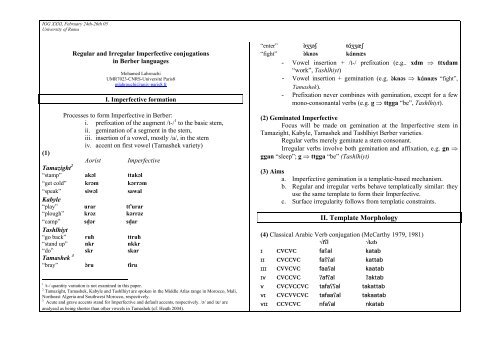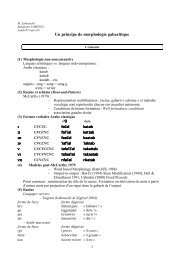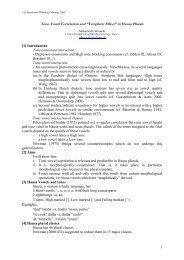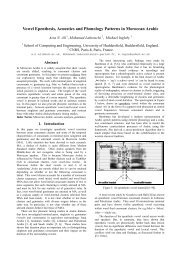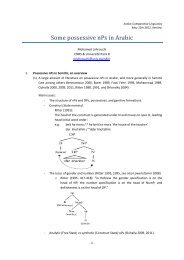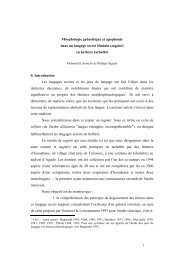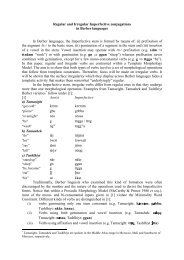Vowel insertion + /t-/ prefixation - Mohamed Lahrouchi
Vowel insertion + /t-/ prefixation - Mohamed Lahrouchi
Vowel insertion + /t-/ prefixation - Mohamed Lahrouchi
You also want an ePaper? Increase the reach of your titles
YUMPU automatically turns print PDFs into web optimized ePapers that Google loves.
IGG XXXI, February 24th-26th 05<br />
University of Roma<br />
Regular and Irregular Imperfective conjugations<br />
in Berber languages<br />
<strong>Mohamed</strong> <strong>Lahrouchi</strong><br />
UMR7023-CNRS-Université Paris8<br />
mlahrouchi@univ-paris8.fr<br />
I. Imperfective formation<br />
Processes to form Imperfective in Berber:<br />
i. <strong>prefixation</strong> of the augment /t-/ 1 to the basic stem,<br />
ii. gemination of a segment in the stem,<br />
iii. <strong>insertion</strong> of a vowel, mostly /a/, in the stem<br />
iv. accent on first vowel (Tamashek variety)<br />
(1)<br />
Aorist Imperfective<br />
Tamazight 2<br />
“stamp” ak´l ttak´l<br />
“get cold” kr´m k´rr´m<br />
“speak” siw´l sawal<br />
Kabyle<br />
“play” urar tt s urar<br />
“plough” kr´z k´rr´z<br />
“camp” sd2´r sd2ar<br />
Tashlhiyt<br />
“go back” ruħ ttruħ<br />
“stand up” nkr nkkr<br />
“do” skr skar<br />
Tamashek 3<br />
“bray” ´$ru ti@ru<br />
1 /t-/ quantity variation is not examined in this paper.<br />
2 Tamazight, Tamashek, Kabyle and Tashlhiyt are spoken in the Middle Atlas range in Morocco, Mali,<br />
Northeast Algeria and Southwest Morocco, respectively.<br />
3 Acute and grave accents stand for Imperfective and default accents, respectively. /´/ and /Q/ are<br />
analysed as being shorter than other vowels in Tamashek (cf. Heath 2004).<br />
“enter” ´$ZZ´S tA@ZZQS<br />
“fight” ´$kn´s kA@nnQs<br />
- <strong>Vowel</strong> <strong>insertion</strong> + /t-/ <strong>prefixation</strong> (e.g.. xdm ⇒ ttxdam<br />
“work”, Tashlhiyt)<br />
- <strong>Vowel</strong> <strong>insertion</strong> + gemination (e.g. ´$kn´s ⇒ kA@nnQs “fight”,<br />
Tamashek).<br />
- Prefixation never combines with gemination, except for a few<br />
mono-consonantal verbs (e.g. g ⇒ ttgga “be”, Tashlhiyt).<br />
(2) Geminated Imperfective<br />
Focus will be made on gemination at the Imperfective stem in<br />
Tamazight, Kabyle, Tamashek and Tashlhiyt Berber varieties.<br />
Regular verbs merely geminate a stem consonant.<br />
Irregular verbs involve both gemination and affixation, e.g. gn ⇒<br />
ggan “sleep”; g ⇒ ttgga “be” (Tashlhiyt)<br />
(3) Aims<br />
a. Imperfective gemination is a templatic-based mechanism.<br />
b. Regular and irregular verbs behave templatically similar: they<br />
use the same template to form their Imperfective.<br />
c. Surface irregularity follows from templatic constraints.<br />
II. Template Morphology<br />
(4) Classical Arabic Verb conjugation (McCarthy 1979, 1981)<br />
√f÷l √ktb<br />
I CVCVC fa÷al katab<br />
II CVCCVC fa÷÷al kattab<br />
III CVVCVC faa÷al kaatab<br />
Iv CVCCVC /af÷al /aktab<br />
v CVCVCCVC tafa÷÷al takattab<br />
vI CVCVVCVC tafaa÷al takaatab<br />
vII CCVCVC nfa÷al nkatab
IGG XXXI, February 24th-26th 05<br />
University of Roma<br />
(5) Guerssel & Lowenstamm (1993)<br />
- The number of templates listed in (4) are reduced by<br />
suggesting that CA verbal forms use a unique template as<br />
given in (6):<br />
(6) CV[CV]CVCV<br />
(7) forms II, III, IV and VII of the root √ktb “write”:<br />
a. Form II b. Form III<br />
k t b k t b<br />
| | | | | |<br />
C V C V C V C V C V C V C V C V<br />
| |<br />
a a<br />
[kattab]<br />
[kaatab]<br />
c. Form IV d. Form VII<br />
/ k t b n k t b<br />
| | | | | | | |<br />
C V C V C V C V C V C V C V C V C V C V<br />
| | |<br />
a a a<br />
[/aktab] [nkatab]<br />
Internal (greyed) and external (italicised) sites act as the head of<br />
the formation; the identification of one of them leads to the derivation one<br />
verbal form.<br />
(8) Classical Arabic internal plurals<br />
sg pl<br />
“sword” rum rimaa<br />
“mountain” Zabal Zibaal<br />
“sea” bar biaar<br />
“star” naZm nuZuum<br />
Asfour (2001) and Kihm (2003) suggest that CA internal plurals<br />
use an empty derivational site located in the template between C 2 and C 3 .<br />
(9) Berber internal plurals (Idrissi 2001):<br />
Berber plurals such as: awtul (sg) ⇒ iwtal (pl) “hare”, asrdun<br />
(sg) ⇒ isrdan (pl) “mule”, asyrs (sg) ⇒ isyras “bag”, asƒun (sg) ⇒<br />
isƒwan (pl) “rope”, are analysed in the same way.<br />
(10) Kabyle Negative Preterit (Bendjaballah 1999)<br />
Aorist Negative Preterit<br />
“work” xD´m xDim<br />
“dive” bb´“ bbi“<br />
“go down” aD´r uDir<br />
“quote” BD´r BDir<br />
The Negative Preterit marker /i/ results from the activation of the<br />
empty site between C 2 and C 3 .<br />
III. Data<br />
The Geminated Imperfective involves verbs that contain:<br />
- no more than three consonants, none of which is a geminate.<br />
- If a verb contains a full vowel it should be in the final position.<br />
Regular verbs (triconsonantal) follow under (11):<br />
(11) Aorist Imperfective<br />
a) Tamazight<br />
“get cold” kr´m k´rr´m<br />
“plough” kr´z k´rr´z<br />
“burn” k w m´d k w´mm´d<br />
“stand up” nk´r n´kk´r<br />
“grill” kn´f k´nn´f<br />
b) Tashlhiyt<br />
“hunt” g w mr g w mmr<br />
“enter” kSm kSSm<br />
“itch” frd ffrd<br />
“plough” krz kkrz
IGG XXXI, February 24th-26th 05<br />
University of Roma<br />
“rent” kru krru<br />
c) Kabyle<br />
“crush” br´c b´rr´c<br />
“cross” zg´r z´gg´r<br />
“work” xD´m x´dd´m<br />
“forbidden” gD´l g´dd´l<br />
“make swell” bz´g b´zz´g<br />
d) Tamashek<br />
“fight” ´$kn´s kA@nnQs<br />
“learn” ´$lm´d lA@mmQd<br />
“follow” ´$lk´m hA@kkQm<br />
“destroy” ´$hl´k hA@llQk<br />
“walk” ´$rg´h rA@ggQh<br />
These verbs all geminate one stem consonant at the Imperfective.<br />
By contrast, verbs under (12) use both gemination and affixation to form<br />
their Imperfective:<br />
(12)<br />
a) Tamazight<br />
“fall” d1r t1t1ar<br />
“overnight” n´s n´ssa<br />
“be” g t´gga / tt´g<br />
“wash” ´gW t´ggWa<br />
“come from” ´kk t´kka<br />
b) Tashlhiyt<br />
“kill” nƒ nqqa<br />
“spend the day” kl klla<br />
“be, become” g ttgga<br />
“eat” SS Stta<br />
“hit” ut kkat<br />
“put out” d1i t1t1ay<br />
c) Kabyle<br />
“stick” g´r ggar<br />
“give” ´fk tt s ak<br />
“fall, go down” ´rs t s rus<br />
“suppurate” fi t s fay<br />
“sleep” ´d`s` t`tàs`<br />
d) Tamashek<br />
“give” Q$kf hA@kk<br />
“do” Q$j tA@jj(a)<br />
“hit” ´$w´t t´wwA@t<br />
“say” Q$nn jA@nn<br />
“kill” Q$NF nA@qq<br />
Different kinds of verbs are distinguished in (12):<br />
i. verbs using both gemination and vowel <strong>insertion</strong> (e.g.<br />
Tamashek: nA@qq; Tamazight: n´ssa, t1t1ar; Tashlhiyt: ggan,<br />
nqqa; t1t1ay; Kabyle: ggar, t`tàs`),<br />
ii. verbs using /t-/ affixation and vowel <strong>insertion</strong> (e.g. Tamazight:<br />
tt´g; Tashlhiyt: Stta; Kabyle: tt s ak, t s fay, t s rus),<br />
iii. verbs using /t-/ affixation, vowel <strong>insertion</strong> and gemination (e.g.<br />
Tamazight: t´gga, t´ggWa, t´kka; Tamashek: t´wwA@t, tA@jj(a);<br />
Tashlhiyt: ttgga),<br />
iv. some verbs change completely (e.g. Tashlhiyt: ut ⇒ kkat,<br />
Tamashek: Q$kf ⇒ hA@kk),<br />
v. other verbs use unusual affixes (e.g. Tamashek: Q$nn ⇒ jA@nn,<br />
Tashlhiyt: SS ⇒ Stta)<br />
IV. Phonological account<br />
Tashlhiyt Berber unfixed gemination:<br />
- Dell & Elmedlaoui’s (1988) syllable-based analysis:<br />
“The segment which is geminated in the Imperfective stem is that segment which is<br />
syllabified as an onset by Core Syllabification in the basic stem.” (p. 11)<br />
However, this analysis:<br />
- Does not involve irregular verbs as given in (12).<br />
- Is limited to Tashlhiyt Berber where gemination is unfixed.<br />
- Seems unnecessary in the case the geminated consonant is<br />
invariably C 2 .
IGG XXXI, February 24th-26th 05<br />
University of Roma<br />
- Jebbour (1996):<br />
Prosodic account: for any verb to undergo gemination the output<br />
should contain two light syllables.<br />
V. Templatic account<br />
Tri-consonantal verbs<br />
(13) CVCV Model (Lowestamm 1996),<br />
Within CVCV model templates consist of a strict alternation of CV units.<br />
(14) Berber peripheral vowels<br />
Following Kabbaj (1990), Lowenstamm (1991), Bendjaballah (1999,<br />
2000) and Idrissi (2000), Berber peripheral vowels are analysed as being<br />
phonologically long; they are associated with two V slots:<br />
This parameter is limited to the skeletal tier. It has no effect on the<br />
phonetic lengthening of the vowels.<br />
(15) - Why does C 3 never geminate at the Imperfective stem?<br />
[16] Imperfective Template<br />
C 1 V [C V] C 2 V C 3 V<br />
(17) Tamazight<br />
(a)<br />
C 1 V C V C 2 V C 3 V<br />
| | | | |<br />
n ´ k ´ r<br />
[n´kk´r]<br />
(b)<br />
C 1 V C V C 2 V C 3 V<br />
| | | |<br />
n k ´ r<br />
*[nk´rr]<br />
(18) Sonority effect<br />
Verbs that geminate C 1 instead of C 2 in Tashlhiyt all contain<br />
sonorants (liquids or nasals) in C2 position.<br />
(19)<br />
“Any segment is prohibited to geminate at the Imperfective stem in Tashlhiyt Berber if it is<br />
the most sonorous segment in the basic stem.”<br />
C 1 germination: a “subsidiary” operation that overcomes<br />
prohibited C 2 gemination. Cf. Tiberian Hebrew “compensatory<br />
lengthening” (nominal derivation: naggar “carpenter”, sippuur “story”<br />
opposed to paaraaS “horseman” and baaheret “white spots on the skin”;<br />
verbal derivation: kitteb “write” vs. beerak “bless”).<br />
VI. Mono- and bi-consonantal verbs<br />
The so-called irregular verbs derive their Imperfective with a<br />
combination of different operations. Their Imperfective size depends on<br />
their aorist form. That is to say:<br />
“the shorter the aorist form is, the more numerous the operations used to<br />
transform the verb are.”<br />
Minimality Word Constraint in Prosodic Morphology (cf. McCarthy &<br />
Prince 1986 et seq.): each word contains at least one foot (or two moras).
IGG XXXI, February 24th-26th 05<br />
University of Roma<br />
(20) mono-and bi-consonantal representations:<br />
a) Tamazight<br />
C V ⇒ C V C V C V C V<br />
| | |<br />
g t ´ g a<br />
[g] [t´gga]<br />
C V C V ⇒ C V C V C V C V<br />
| | | | |<br />
n ´ s n ´ s a<br />
[n´s] [n´ssa]<br />
b) Kabyle<br />
C V C V ⇒ C V C V C V C V<br />
| | | |<br />
f i t s f a y<br />
[fi] [t s fay]<br />
C V C V ⇒ C V C V C V C V<br />
| | | |<br />
g ´ r g a r<br />
[fi] [ggar]<br />
c) Tamashek<br />
C V C V ⇒ C V C V C V C V<br />
| | |<br />
Q Z t A Z<br />
[Q$Z] [tA@ZZ]<br />
C V C V C V ⇒ C V C V C V C V<br />
| | | |<br />
Q N F n A q<br />
[Q$NF] [nA@qq]<br />
d) Tashlhiyt<br />
.<br />
Aorist Imperfective<br />
C V C V ⇒ C V C V C V C V<br />
|<br />
SS S t a<br />
[SS] [Stta]<br />
C V C V ⇒ C V C V C V C V<br />
| | |<br />
k l k l a<br />
[kl] [klla]<br />
VII. Tamashek triconsonantal verbs<br />
Triconsonantal Imperfective forms given in (11c) use both C 2<br />
gemination and vowel <strong>insertion</strong> (vowel lengthening according to Heath<br />
2004). They need one slot more in their template:<br />
(21) Tamashek<br />
C 1 V C V C 2 V C 3 V<br />
| | | | |<br />
* l A m Q d<br />
(23) Classical Arabic plurals<br />
“habitant” saakin sukkaan<br />
“student” taalib tullaab<br />
“reader” qaari÷ qurraa÷<br />
“worker” /aamil /ummaal
IGG XXXI, February 24th-26th 05<br />
University of Roma<br />
(22) C 1 V C V C 2 V C V C 3 V<br />
Questions:<br />
- Why don’t all triconsonantal verbs in Berber use both sites?<br />
- Under what conditions are both sites activated?<br />
- Which site stands for the head of the formation?<br />
Conclusion<br />
- Mono- and bi-consonantal verbs are templatically constrained<br />
at the Imperfective stem.<br />
- Gemination, affixation and vowel <strong>insertion</strong> are used to fill the<br />
Imperfective template.<br />
References:<br />
Asfour, F-M. 2001. Theoretische Aspekte der internen Pluralbildung im Klassischen<br />
Arabisch. Diplomarbeit zur Erlangung des Magistergrades, Universität Wien.<br />
Basset, A. 1929. Le verbe berbère: étude de thèmes. Ernest Leroux. Paris.<br />
Bendjaballah, S. 2001. The « Negative Preterit » in Kabyle Berber. Folia Linguistica<br />
XXXIV/3-4 :185-220.<br />
Cortade, J-M. 1969. Essai de grammaire touareg (dialecte de l’Ahaggar). PhD.<br />
Université d’Alger.<br />
Dallet, J-M. 1982. Dictionnaire kabyle-français. Selaf. Paris.<br />
Dell, F. & Elmedlaoui, M. 1988. Syllabic Consonants in Berber: Some New Evidence.<br />
Journal of African Languages and Linguistics 10, 1-17.<br />
Guerssel, M. & Lowenstamm, J. 1993. The Derivational Morphology of the Classical Arabic<br />
Verbal System. ms. UQAM & Université Paris 7.<br />
Heath, J. Grammar of Tamashek (Tuareg of Mali). Ms. University of Michigan.<br />
Idrissi, A., 2000. On Berber plurals. In J. Lecarme, J. Lowenstamm & U. Shlonsky<br />
(Eds.), Research in Afroasiatic Grammar, Benjamins, Amsterdam.<br />
Kabbaj, O. 1990. La structure syllabique de l’arabe marocain. MA Thesis. UQAM :<br />
Montréal.<br />
Kihm, A. 2003. Les pluriels internes de l’arabe : système et conséquences pour<br />
l’architecture de la grammaire. Recherches Linguistiques de Vincennes, n° 32 : 109-156.<br />
Louali, N. & Philippson, G. 2003. Le thème de l’aoriste intensif : formes multiples,<br />
contenu unique. Collection d’articles 2 ème Bayreuth Frankfurter Kolloquium zur<br />
Berberologie (9-13 juillet 2002), Berber Studies, Rüdiger Köppe Verlag.<br />
Lowenstamm, J. 1991. Vocalic Length and Centralization in Two Branches of Semitic<br />
(Ethiopic and Arabic). In. A.S. Kaye (ed.), Semitic Studies in honor of Wolf Leslau on<br />
the occasion of his eighty-fifth birthday. Wiesbaden: Otto Harrassowitz, 949-965.<br />
Lowenstamm, J., 1996. CV as the only syllable type. In. J. Durand & B. Laks (Eds.),<br />
Current Trends in Phonology : Models and Methods: 419-441. CNRS, ESRI, Paris X.<br />
McCarthy, J., 1979. Formal problems in Semitic phonology and morphology. PhD dissertation,<br />
MIT, distributed by Indiana University Linguistics Club, Garland Press. New<br />
York.<br />
McCarthy, J. and A. Prince. 1986. Prosodic Morphology, ms. University of Massachusetts,<br />
Amherst and Brandeis University<br />
Taïfi, M. 1991. Dictionnaire tamazight-français. L’Harmattan-Awal. Paris.


